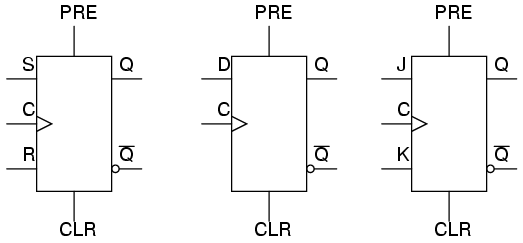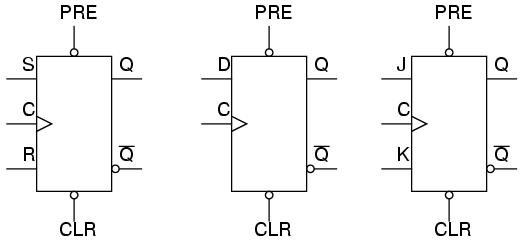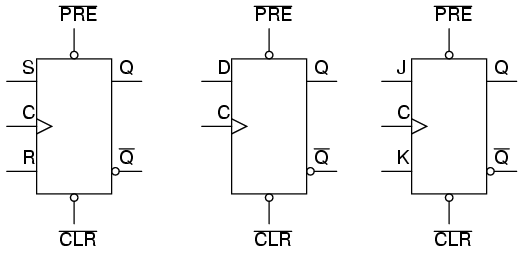The normal data inputs to a flip flop (D, S, and R, or J and K) are referred to as synchronous inputs because they have effect on the outputs (Q and not-Q) only in step, or in sync, with the clock signal transitions.
These extra inputs that I now bring to your attention are called asynchronous because they can set or reset the flip-flop regardless of the status of the clock signal. Typically, they’re called preset and clear:

When the preset input is activated, the flip-flop will be set (Q=1, not-Q=0) regardless of any of the synchronous inputs or the clock. When the clear input is activated, the flip-flop will be reset (Q=0, not-Q=1), regardless of any of the synchronous inputs or the clock.
So, what happens if both preset and clear inputs are activated? Surprise, surprise: we get an invalid state on the output, where Q and not-Q go to the same state, the same as our old friend, the S-R latch!
Preset and clear inputs find use when multiple flip-flops are ganged together to perform a function on a multi-bit binary word, and a single line is needed to set or reset them all at once.
Asynchronous inputs, just like synchronous inputs, can be engineered to be active-high or active-low. If they’re active-low, there will be an inverting bubble at that input lead on the block symbol, just like the negative edge-trigger clock inputs.

Sometimes the designations “PRE” and “CLR” will be shown with inversion bars above them, to further denote the negative logic of these inputs:

Summary
Asynchronous inputs on a flip-flop have control over the outputs (Q and not-Q) regardless of clock input status.
These inputs are called the preset (PRE) and clear (CLR). The preset input drives the flip-flop to a set state while the clear input drives it to a reset state.
It is possible to drive the outputs of a J-K flip-flop to an invalid condition using the asynchronous inputs, because all feedback within the multivibrator circuit is overridden.
